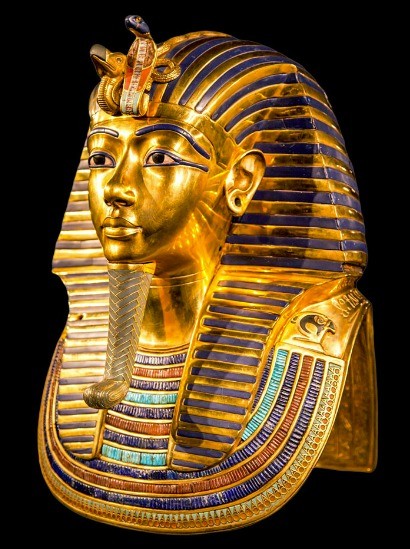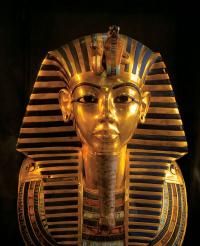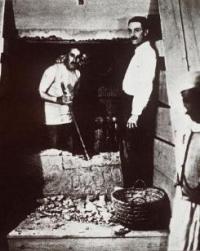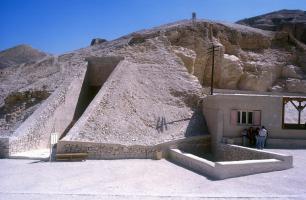The curse of Tutankamen's tomb
Today all archaeologists agree that the most important archaeological discovery of the century must be considered the discovery of Tutankhamen's tomb: the discovery occurred in 1922 in the Valley of the Kings by the English archaeologists Carnarvon and Carter. The two English archaeologists had received permission from the Egyptian government in 1902 to begin research on the tomb but in reality, due to various problems, the two archaeologists began their work a few years after the end of the First World War (this delay in the beginning of the work aimed at finding Tutankhamen's tomb was due both to the outbreak of the First World War and to personal problems of the two archaeologists).

In November 1922 they were certain that they had found Tutankhamen's tomb. It was not possible to keep secret this great archaeological discovery which occurred in the Valley of the Kings so that the news of the sensational discovery went all over the world.
However, shortly after this sensational discovery, many of those who had been directly or indirectly involved in this archaeological event died in a mysterious and disturbing way. To be more precise, in a few years twenty-two people who had either come into contact with the tomb or were interested in it from a scientific point of view died. Such deaths were considered immature and inexplicable. Thus was born the belief that these people had been struck by a curse formulated by Egyptian priests which protected Tutankhamen's tomb from all those who wanted to desecrate it.
We must say that there was a lot of nervousness already in November 1922 both among those involved in the excavations and among the scientists who participated in this great archaeological undertaking. This growing nervousness had been caused by the discovery of a terracotta tablet found by Carter in the antechamber of Tutankhamen's tomb. After a few days of finding it, Gardiner (a collaborator of Carter and Carnarvon) managed to decipher the hieroglyphics and a terrifying phrase emerged. In fact on the tablet it was written:
Death will strike with its wings anyone who disturbs Pharaoh's sleep.
Carter, Carnarvon and Gardiner were not at all afraid of this curse but some of their collaborators appeared frightened. Carter feared that if the Egyptian laborers who collaborated with him learned of this curse they would immediately abandon their work. For this reason he decided that it was preferable to make the terracotta tablet disappear from the protocols but he was unable to erase it from his memory, so much so that the English archaeologist often mentioned it with his collaborators even if he had decided not to photograph it.
We must also highlight another disturbing detail that aroused some concern in the collaborators of the two English archaeologists: a second curse was found inside Tutankhamen's tomb.
It consisted of the following sentence written inside a magical figure:
It is I who repel the tomb robbers with the flame of the desert. I protect Tutankhamen's tomb.
In general curses were present in Egyptian religion and in most cases they were formulated either by the Pharaoh or by the priests and sometimes were also attributed to the gods.
It is therefore not surprising that Tutankhamen's tomb was protected from such curses formulated by Egyptian priests and magicians. What aroused great wonder, however, was that twenty-two people who had played a role in the discovery of the tomb died in a mysterious way within a few years.
Five hypotheses have been formulated to explain these numerous deaths:
- random events
- the presence of a very effective curse against the desecrators of the tomb
- the presence of poisons in the tomb
- the presence of radioactive substances
- the presence of pathogenic microorganisms
Before taking into consideration each of these hypotheses, let's describe how Carnarvon's death occurred, which is probably the most disturbing death among those that occurred among the discoverers of the tomb.
In the first days of April '23 Carter received the news that Carnarvon was seriously ill. He had fallen victim to a mysterious fever in Cairo that did not want to disappear. Carnarvon died mysteriously but what frightened everyone most were two details: Carnarvon's sister stated that he was deliriously speaking to Tutankamen and the last words that the English archaeologist spoke were:
I hear Tutankamen calling me. I'm going with him.
Secondly, at the very moment Carnarvon died there was a sudden lack of electricity which returned immediately after the death of the English archaeologist. The technicians of the Cairo power plant were immediately questioned and they stated that there was no explanation capable of justifying the sudden lack and return of electricity. They made it clear that for them there was no natural explanation for this phenomenon.
It was then that for the first time scientists and even journalists spoke about the curse written on the terracotta tablet and a real panic spread among the experts when in the same year two other men who had participated in the excavations of Tutankhamen's tomb died mysteriously.
Let now consider the five formulated hypotheses. We will begin by assuming that all deaths are due exclusively to fortuitous and random events. This is difficult to sustain for at least two reasons: first of all, it appears implausible that twenty-two out of twenty-five people died in such a disturbing and premature way due to a simple coincidence or due to random and fortuitous events; secondly, some deaths, such as that of Carnarvon were preceded and accompanied by events that seemed of supernatural origin.
As an example to explain how low the statistical probabilities that such deaths are simply due to random and fortuitous events are, let's imagine tossing a coin in the air: statistically there should be a 50% chance of heads and a 50% chance of tails. In reality, however, there is a third possibility and that is that the currency remains in the balance but this possibility is so remote that it is never taken into consideration in the statistical calculation of probabilities. In my opinion, the probabilities that the twenty-two disturbing and mysterious deaths are due to chance are equal to the probabilities that when throwing a coin in the air neither heads nor tails come up but that the coin remains in the balance.
Let's assume instead that the numerous deaths are due to a curse formulated by Egyptian priests through magical rites aimed at protecting the Pharaoh's mummy from the desecrators of the tomb. This explanation is insufficient to explain all the deaths and should be integrated with other explanations such as the presence of poisons in the tomb or radioactive substances. The main weakness to this theory is that the discoverery of other tombs did not have the same tragic consequences as the discovery of the Tutankhamen's tomb. To this objection, the supporters of this hypothesis respond that the magical rites performed by the priests who formulated the curse that was supposed to protect Tutankhamen's tomb were more effective than those carried out to protect the tombs of other Pharaohs.
Let us now take into consideration the third hypothesis: deaths are due to the presence of poisons both inside the tomb and in Tutankhamen's mummy. The weakness of this hypothesis is that if all these people had died from poisoning, the supernatural phenomena that preceded and accompanied some of these deaths cannot be explained.
The fourth hypothesis formulated to resolve this mystery is the presence of radioactive substances inside the tomb or in some ornaments found in Tutankhamen's mummy. This hypothesis is supported by a limited number of authors who assumed that ancient Egyptian scientists had scientific knowledge superior to what we can imagine.
The last hypothesis is the presence within the tomb of pathogenic microorganisms (viruses, bacteria and fungi) which caused fatal infectious diseases. The pathogenic microorganisms would also have been present in Tutankhamen's mummy so that they would have infected also those persons who had studied the mummy without participating in the discovery of Tutankhamen's tomb.
Some authors have proposed to unify two of the proposed hypotheses, namely the presence of a curse and the presence of poisons both in the tomb and in Tutankhamen's mummy so that the deaths accompanied by supernatural phenomena would have been a consequence of the curse formulated by the priests while the inexplicable deaths would have been a consequence of the poisons. According to this hypothesis the priests would not have limited themselves only to carrying out magical rites but would also have inserted such poisons in the tomb and in the mummy knowing that the magical rites would not have affected all the desecrators of Tutankhamen's tomb.
The Egyptian priests were expert connoisseurs of many poisons as well as capable of carrying out magical rites of various types since in the Egyptian religion the priests were also responsible for carrying out magical rituals aimed at protecting the pharaoh and at striking the enemies of the pharaoh and Egypt.
Tutankhamen is a Pharaoh who attracted the attention of ancient Egyptian scholars not only for the many death of the discoverers but also because his own death is shrouded by a profound mystery. The autopsy carried out on Tutankhamen's mummy demonstrated that the Pharaoh had died at the age of about eighteen, not by natural causes but of a violent death. The Pharaoh's death was probably caused by a cerebral hemorrhage due to a head injury attributable to a violent hit by a blunt force, most likely a very heavy stick.






























